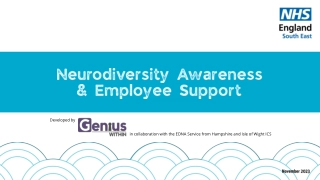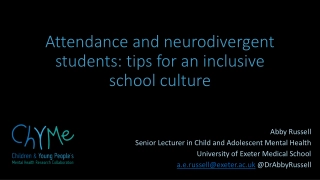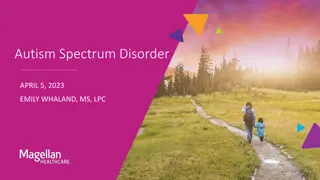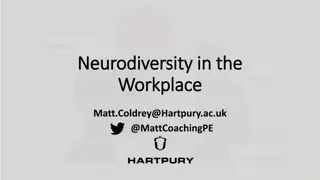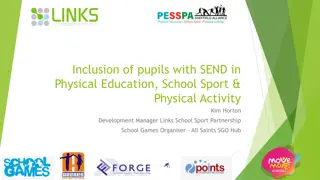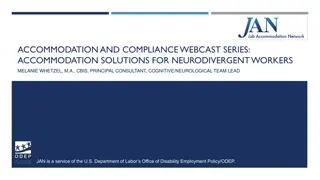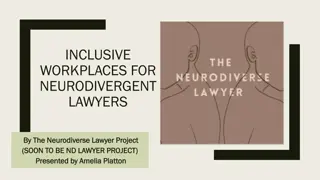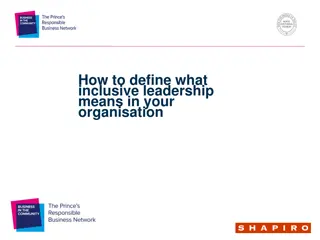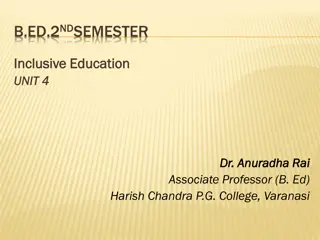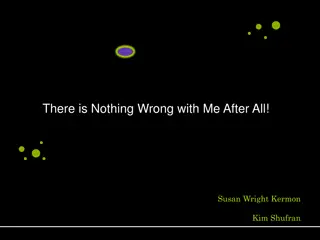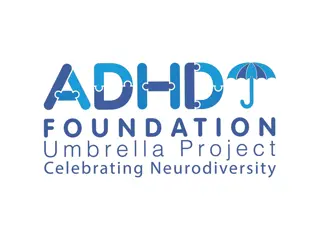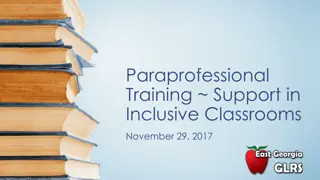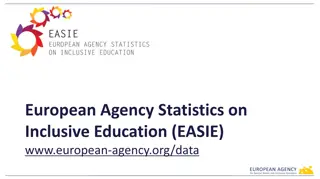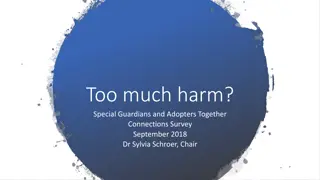Understanding Neurodiversity and Inclusive Language
This guidance, generated by members of the GM=EqAl Inclusive Language Subgroup, highlights the importance of using respectful and consistent language around neurodiversity, particularly autism. It emphasizes the use of identity-first language and explains key concepts related to neurodiversity and neurocognitive functioning. By adopting inclusive language practices, we can promote understanding and acceptance of neurodivergent individuals.
Download Presentation

Please find below an Image/Link to download the presentation.
The content on the website is provided AS IS for your information and personal use only. It may not be sold, licensed, or shared on other websites without obtaining consent from the author. Download presentation by click this link. If you encounter any issues during the download, it is possible that the publisher has removed the file from their server.
E N D
Presentation Transcript
Inclusive Language Subgroup
Preamble This guidance is the product of discussion and research by members of the GM=EqAl Inclusive Language Subgroup. It is part of a series created to help GM=EqAl members and staff be respectful and consistent in how we talk and write about the issues we work on. It sets out our agreed definitions and terminology around AUTISM. As background, we briefly cover the wider context of NEURODIVERSITY, and explain key concepts in line with the values of GM=EqAl. GM=EqAl is keen for others to share and adopt our language guidance, and welcomes dialogue with partners in order to keep evolving the documents along with our understanding. This guidance has been robustly generated but does not claim absolute authority on any topic. Hosted by
Short version DO use identity-first language i.e. autistic person . use neurodivergent or neuroatypical if that is what the person prefers. DON T use person with autism , person with Autism Spectrum Disorder/Condition or person on the spectrum . use Asperger s Syndrome or high/low-functioning to refer to someone who is autistic make assumptions about which terms people prefer - always check with the person you are speaking to. Hosted by
Neurodiversity Neurodiversity = the biological reality of infinite variation in human neurocognitive functioning and behaviour, similar to biodiversity in the natural world. The term is also used to describe the fast-emerging sub-category of workplace diversity and inclusion that focuses on including people who are neurodivergent. Neurodivergent / Neuroatypical =having cognitive functioning that is different from what is seen as normal , or neurotypical. The neurodiversity paradigm emphasises the bell curve of natural human variation there is no one normal brain type, but a range of traits, skills and challenges arising from genetic variation, which can cluster into recognisable, diagnosible conditions. It contrasts with a medicalised perspective in which forms of neurodivergence are viewed as disorders to be treated. A common misuse of language is to talk of a person s neurodiversity - better would be to talk of their neurodivergence. An individual can be described as neurodivergent, whereas a group - or society as a whole - is neurodiverse. Hosted by
Neurodiversity Forms of neurodivergence include: Autism, Attention Deficit Hyperactivity Disorder (ADHD), Dyslexia, Dyspraxia, Dyscalcula, Pathological Demand Avoidance (PDA) and Tourette s Syndrome (see more examples on the next slide). Most are lifelong developmental conditions, though they may not be obvious in early childhood. ADHD, dyslexia, dyspraxia and dyscalcula are also sometimes described as learning differences. Difficulties with executive function - the mental processes that enable us to plan, focus attention, remember instructions and juggle tasks are common to many forms of neurodivergence. Co-occurrence between different forms of neurodivergence is common. Diagnosis is as much a strategy as a science. While giving someone a label such as dyspraxic may be considered simplistic or reductive, having a diagnosed condition is often key to helping people to unlock support and gain self- acceptance. Hosted by
Neurodiversity Neurodiversity seeks to include and destigmatise people, e.g. people who hear voices or see visions, or people who are plural. Many people with cerebral palsy or epilepsy describe themselves as neurodivergent (though not all). Kassiane Asasumasu, the activist credited with coining the term neurodivergent, intended it to be used in this way: "Neurodivergent refers to neurologically divergent from typical. Autistic people. ADHD people. People with learning disabilities. People with Multiple Schlerosis or Parkinsons or apraxia or cerebral palsy or dyspraxia or no specific diagnosis but wonky lateralization or something. It is not another damn tool of exclusion. It is specifically a tool of inclusion." More information: criticalneurodiversity.com/2017/01/25/schizophrenia-as-neurodiversity/ neuroqueer.com/interview-neuroqueering-the-future/ pluralityresource.org/plurality-information Hosted by
Autism Autism is a form of neurodiversity which affects between 1 and 2% of the UK population. pubmed.ncbi.nlm.nih.gov/16844490 Autism impacts on communication, interaction and sensory processing. It can be associated with high levels of skill in these areas, as well as challenges. Autistic traits are often to do with extremes. Autistic people may be at either end of any given experiential scale, for reasons of hyper/hypo sensitivity, or overcompensation. Autism is not a learning disability. Around 25% of autistic people have a learning disability, and 20 to 30% of people with a learning disability are autistic. bit.ly/3vxlyZx, bit.ly/3jWg6dq Autism is not a mental illness. However, many autistic people experience mental health difficulties often anxiety, depression or trauma associated with (especially early life) pressure to adapt and conform to neurotypical norms and environments. Hosted by
Intersectional considerations Engagement with autism services is often lower among families from diverse cultural and ethnic backgrounds. Providers need to be sensitive to and respect different cultural understandings and histories, while seeking to support autistic people. Some cultures place taboos around neurodivergent behaviours, invoking e.g. punishment from God, or past actions of ancestors. The solution may be seen to lie in prayer, rather than external resources. Where a language has no equivalent word or concept for autism or mental health, extra skill is needed to broach these topics. Fear and shame can lead some parents to prevent or a hide child s diagnosis, yet good post-diagnostic support makes a big difference to their ability to frame a positive autistic identity, for the good of their ongoing mental health and that of their family and supporters. Work is ongoing in GM to help practitioners and interpreters develop good cultural competencies, to build trust and accurately translate conversations so that families with different backgrounds feel well informed and assured. autismgm.org.uk/about-the-project Hosted by
Autism Language Guidance Autistic people are routinely described in a number of ways: Autistic person Person with autism Person on the autism spectrum Person with an autistic spectrum condition (ASC) Person with an autistic spectrum disorder (ASD) The Greater Manchester Autism Consortium (GMAC) works with autistic adults, the majority of whom say they prefer the term autistic adult / autistic person above the other options. This is known as identity-first language, which announces autism as an essential aspect of who a person is, rather than a condition that they have or suffer from . GM=EqAl will follow GMAC and use this identity-first language in our meetings and documents. Hosted by
Autism Language Guidance A minority of autistic people prefer person with autism , i.e. person-first language (which was once prevalent in contexts based on the medical model of disability). Person-first language is common among parents, schools and children s services, where the preference of non-autistic people is sometimes to speak of a child as having autism rather than being autistic . It is worth checking with the individual which form they prefer. Some autistic people simply call themselves neurodivergent . Outdated terms include: Aspergers Syndrome Low functioning or high functioning (formerly used to refer to autistic people with or without a learning disability) If professionals are using dated language in their interactions with autistic people (often due to other schools of thought being current during their training), it is ok to gently make them aware of this. Hosted by
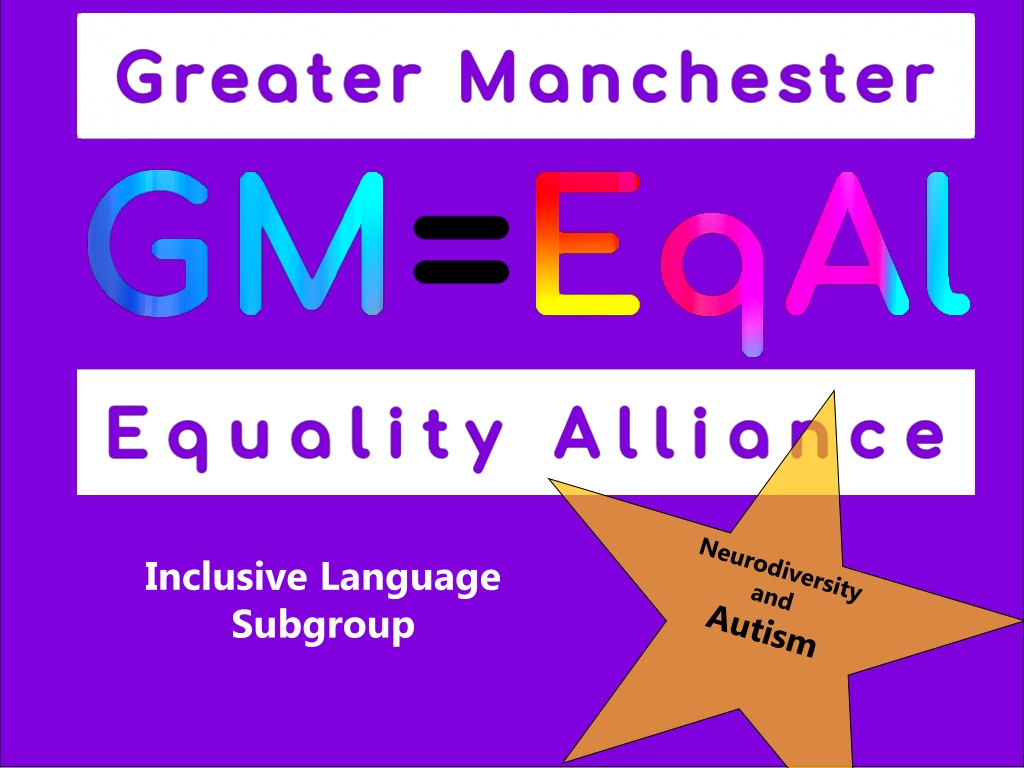
 undefined
undefined



